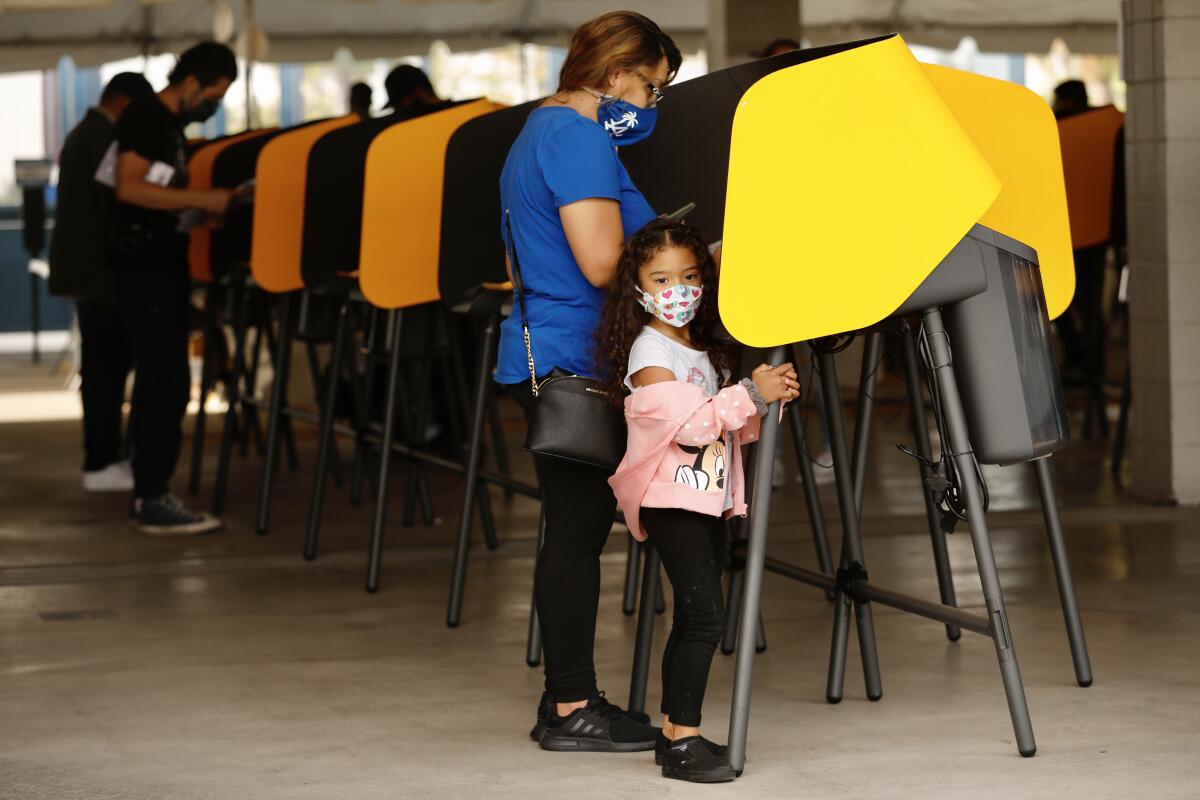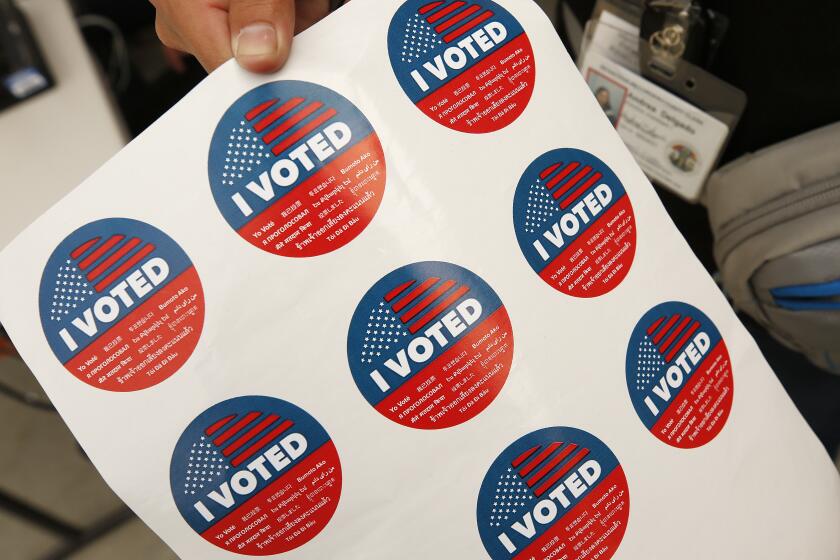Donald Trump has been good for one thing at least: L.A. election voter turnout

- Share via
Who knew President Trump would be so good for Los Angeles elections?
Thanks to what’s expected to be record turnout driven by the make-or-break presidential race, L.A.’s local elections — two runoffs for the city council and Los Angeles Unified school board — will likely see a huge surge in participation. We can also expect a more diverse electorate, including more renters, more young people and more Latino voters, than in previous local elections.
This is no coincidence.
In 2015, voters overwhelmingly approved two ballot measures to move city and Los Angeles Unified school board elections from odd-numbered to even-numbered years to coincide with presidential and gubernatorial elections.
This is the first year L.A. voters get to cast their ballot for federal, state, county, city and school board representatives at the same time.
The new consolidated election is a big change from L.A.’s previous municipal election schedule, when voters went to the polls in the March and May of odd-numbered years. L.A.’s so-called off-cycle elections were the result of Progressive-era reforms in the early 1900s that installed a nonpartisan municipal government in most American cities. Reformers pushed for off-cycle elections to reduce the corrupting influence of political parties and to keep voters focused on local affairs.
California voting system gets mostly rave reviews from voters, many of whom are calling it their ‘best voting experience ever.’
The problem, of course, was that voters were not necessarily focused on local issues, at least not at election time. Turnout was abysmally low in L.A. city elections. Just 10% to 20% of registered voters showed up. It’s not hard to understand why — in a sprawling city like Los Angeles, full of newcomers and where district and even city boundaries can be confusing, many Angelenos feel disconnected from City Hall. And an election in May? Who’s paying attention?
After fewer than 1 in 4 registered voters bothered to cast a ballot in the 2013 mayoral election, civic leaders pushed for change. An appointed Municipal Elections Reform Commission called for charter amendments to change L.A.’s election dates, which commissioners predicted could instantly double the number of people who vote in city races. It could also lead to a more diverse electorate. How? By simply capturing the people who were already primed to vote in gubernatorial and presidential elections, which tend to attract younger voters, renters and Latinos than typically vote in municipal election.
The first test of L.A.’s new election dates came in the primary, which was moved to March so California could be a Super Tuesday state and have more influence in the Democratic primary.
President Trump and Joe Biden battled into Wednesday morning with no clear winner, as major contests remained too close. Biden urged patience, while Trump called the election into question.
As predicted, there was a big increase in participation. In 11 city council and school board races, 33% of registered voters cast a vote, on average. In some city council races, the number of votes cast tripled or quadrupled compared with the previous election.
We should see similarly high participation in the runoff races. Incumbent Councilman David Ryu is facing a challenge from nonprofit leader Nithya Raman. Longtime politician Mark Ridley-Thomas faces attorney Grace Yoo. LAUSD School Board member Scott Schmerelson faces challenger Marilyn Koziatek, a parent who works for a charter school. Patricia Castellanos and Tanya Ortiz-Franklin are running for an open seat on the board.
Even skeptics of changing L.A.’s election dates knew the move would increase voter participation in local elections. But they were worried about the potential downsides. Would voters would show up for the high-profile state and federal races and “drop off” for local races? With so much focus on the presidential race, would grassroots candidates be able to raise money and get their message out? Would local issues be lost in the cacophony of national politics, or be filtered through a partisan lens?
California allows same-day voter registration, so you can still cast a ballot on election day today. Here’s how.
So far, none of the worst fears have come to fruition. Voters did not drop off significantly in the primary. Between 80% and 90% of voters who cast ballots in the primary voted in their council race. It helped that local elections were placed at the top of the ballot in Los Angeles County.
Grassroots candidates managed to push well-known politicians into runoffs. Candidates may have been helped by the city’s new, more generous matching funds program that provides $6 in public money for every $1 qualified candidates raise from city residents. (This was not the case in the LAUSD races, where the same dynamic plays out in every election: Large sums pour in for charter-backed candidates and their union-backed opponents, putting the rest of the field at a huge disadvantage.)
There’s also been plenty of debate over local issues, particularly how the city has managed homelessness and the housing crisis. It helps that there’s been a groundswell of groups, including the L.A. Tenants Union, Black Lives Matter, Ground Game L.A. and many others, that have focused their activism on local government. And, possibly, one upside of the COVID-19 pandemic is that it has forced candidate forums and political communication to be carried out online, which has made it easier for more people to participate.
This is just the first year of L.A.’s new voting schedule. Still, it’s safe to say that Los Angeles can expect greater voter participation going forward. The question now is, how will that change L.A. government?
More to Read
A cure for the common opinion
Get thought-provoking perspectives with our weekly newsletter.
You may occasionally receive promotional content from the Los Angeles Times.








